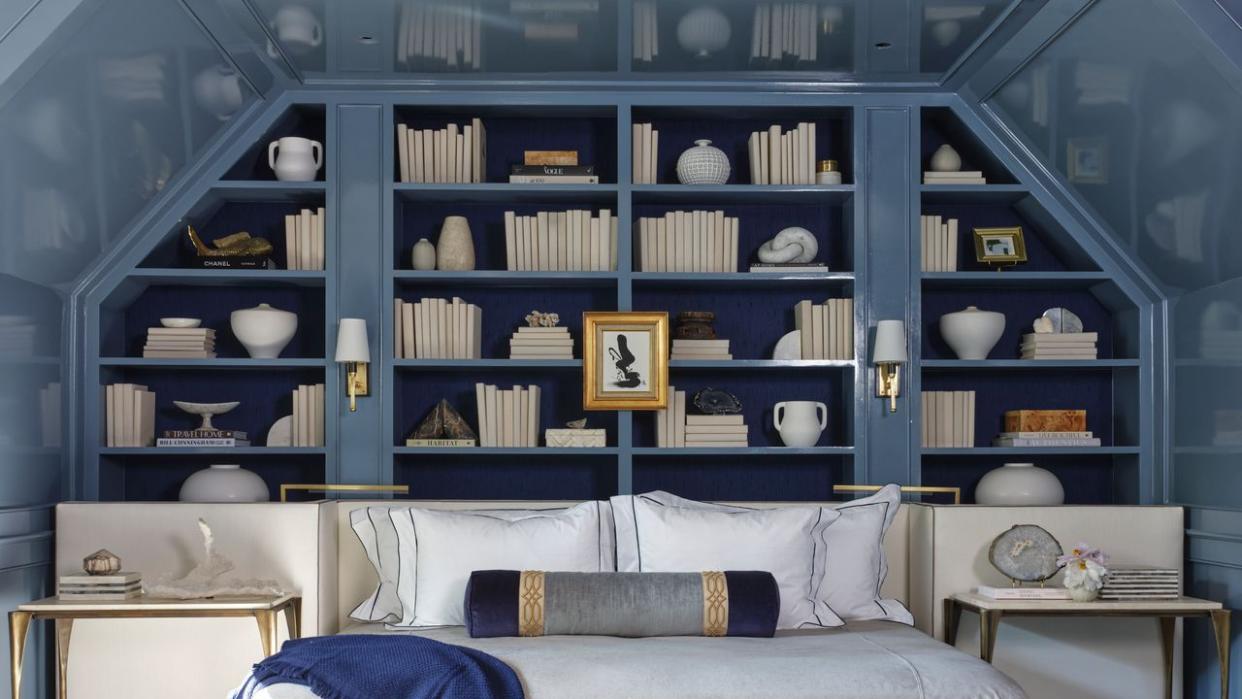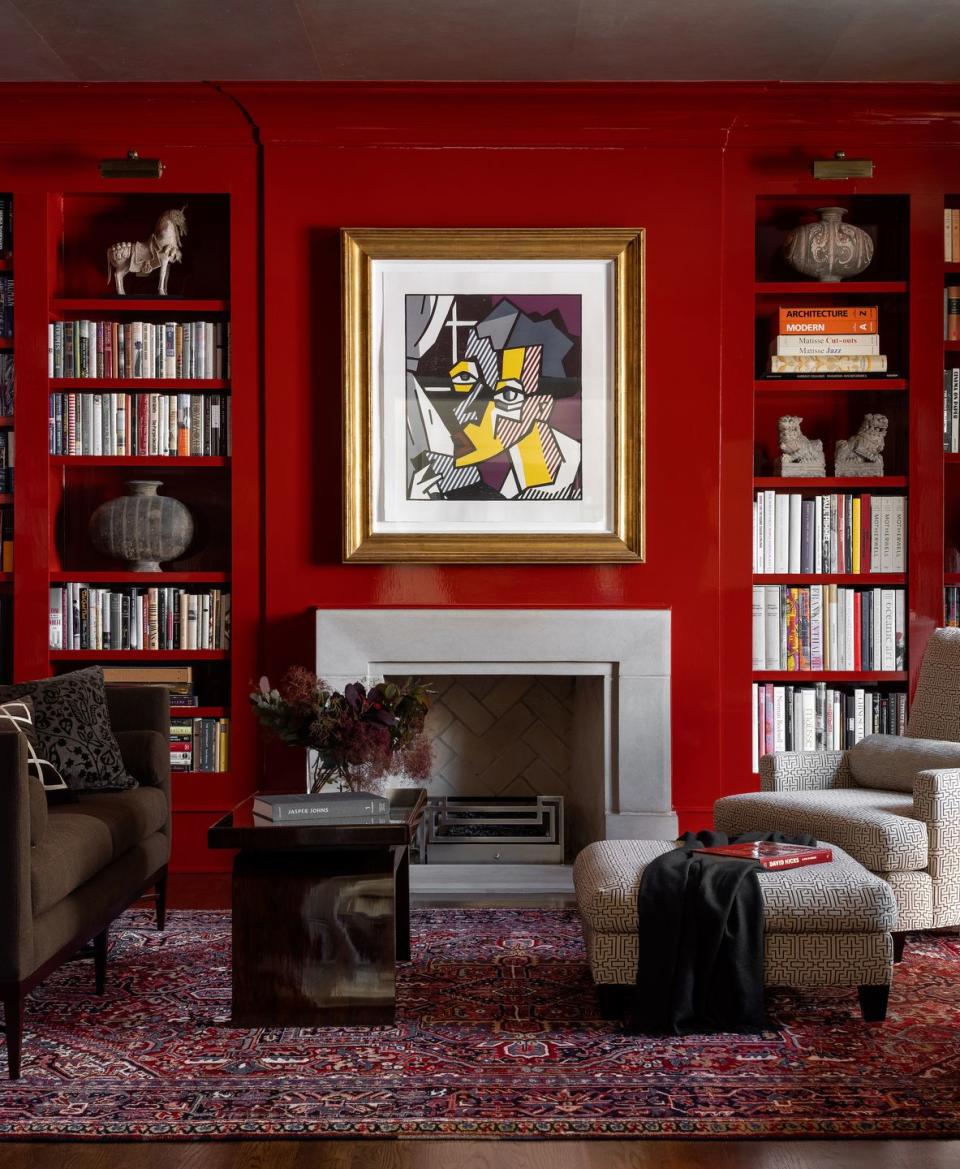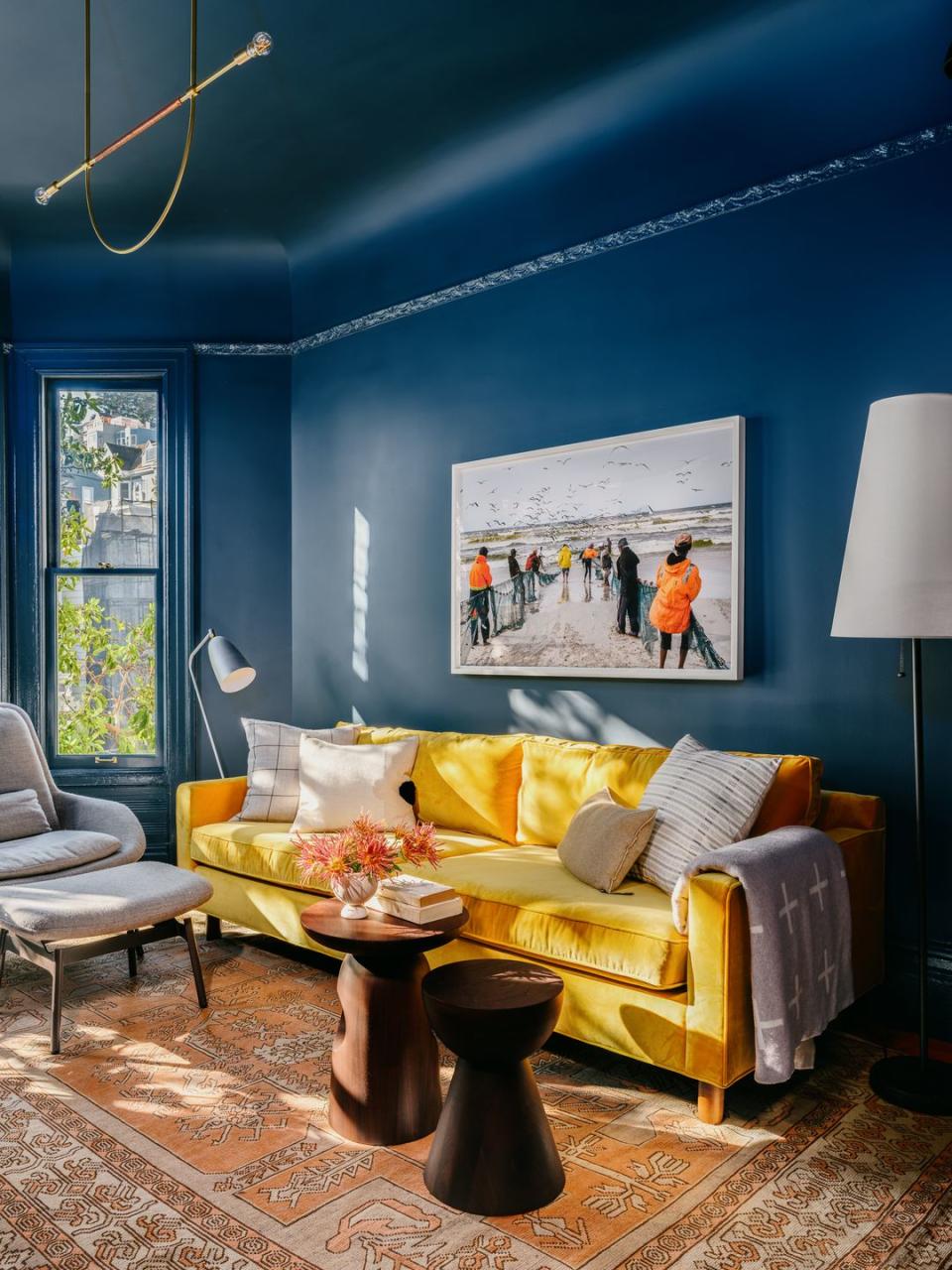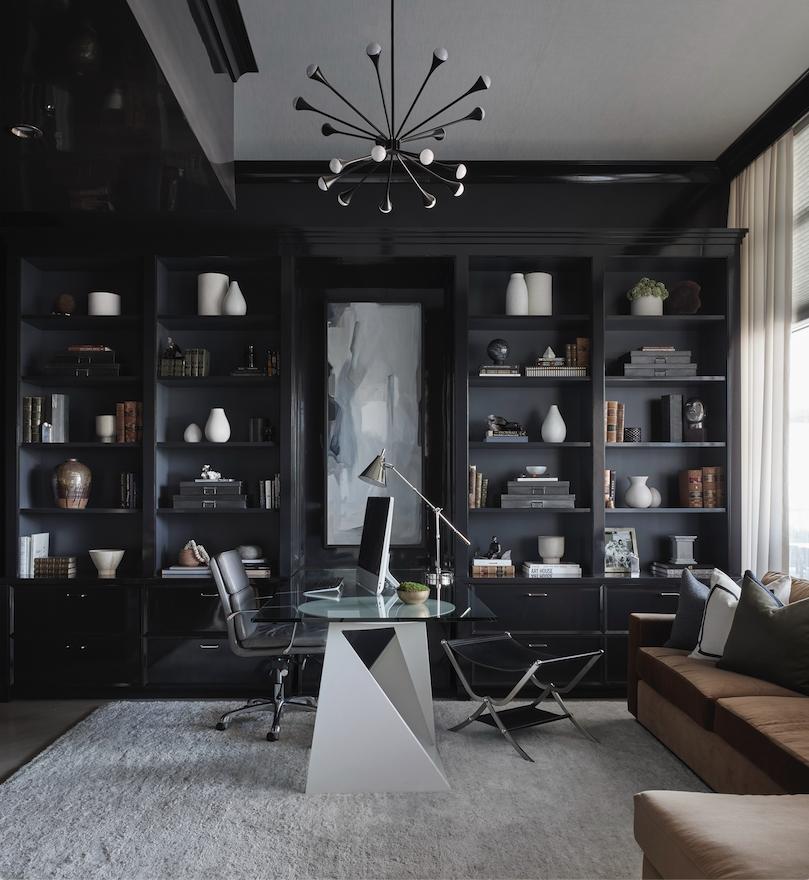The Color Drenching Paint Trend Isn't Going Anywhere

"Hearst Magazines and Yahoo may earn commission or revenue on some items through these links."
Color drenching is proving to be a paint trend that isn’t going away anytime soon. It involves painting every surface of a room—walls, trim, molding, baseboards, built-ins, and ceiling—in a single paint color. It could be a vivid green, moody blue, warm magenta, or classic gray. In any case, the resulting room packs a punch.
“We love a room drenched in vibrant color or even a soft gray, for that matter,” Nashville-based designer Roger Higgins says. “Saturated color adds ambiance and elevates the mood of a room. A bright red library will feel even more dramatic when drenched in high-gloss color, while a room enveloped with soft gray or blue will enhance the feeling of serenity or calm.”
New York City designer Sarah Tract has also been loving the trend. “We just painted an entire office in a dark green plaster finish,” she says. “When it was complete, we decided the trim and ceiling needed to match to get the full effect of paint encompassing the entire space.”
Painting a room entirely in one color not only offers a fresh, contemporary feel, but it's also cost effective compared with wallpaper or a full redesign. If you’re eager to learn more about color drenching, we’ve laid out everything you need to know. Explore the possibilities, gather tips from Higgins, Tract, and other designers, and then embark on an interior makeover of your own.
What Is Color Drenching?
As we explained above, color drenching means painting all of the elements of a room—including metal fixtures like radiators—in the same paint color. You can use different paint finishes to highlight different features (more on that below), or you can use a matte finish, like Farrow & Ball's Dead Flat finish, on everything. The company used the term "color drenching" to describe painting an entire room in this finish, but the technique has been around for ages, especially in England.
Where to Use Color Drenching
Picking a room that could use a high-impact update but isn’t a huge focal point in your home. “We usually stick to rooms that can be readily closed off to other spaces and are not open concept,” says Clara Jung of Banner Day Interiors in Berkeley, California. “For most of our clients, I would recommend a room that is less used, [like a] guest room, den, etc.”
Chicago designer Brynn Olson adds that cozy spaces, including a sitting room and library, are ideal options. “Powder rooms can be transformed into jewel box spaces in dramatically drenched colors,” she says.
While Higgins generally uses color drenching in small spaces, like a butler’s pantry, he loves the effect of a saturated kitchen or dining room. “Add a high-gloss finish, and you’ll elevate the look even more,” the designer says.
The method can also be used to mask certain less appealing home features. “It’s an excellent way to camouflage undesirable wainscoting or heavy moldings while giving a space a modern update,” says Gabriela Eisenhart of Silo Studios in Atlanta. “The moody, dramatic effect works wonders, particularly in dining rooms or studies.”
How to Try the Color Drenching Trend at Home
Color drenching may seem simple, but there are a few factors to consider—from the room you paint to the items you furnish it with. Get expert advice below.

Choose a Color
Pick a color that brings you delight. If you love it, it’s sure to impress you every time you see it. “Committing to a color is step one, but selecting the right undertone of the color is really where you want to be mindful, especially when creating a monochromatic space,” says Los Angeles designer Jenn Feldman. “Look for colors that are saturated in light value but void of yellow or red undertones that can make the colors look punchy or bright. Look for colors with a smoked-out gray or greige undertone, which will feel more classic and timeless, allowing you to layer in effortlessly throughout the space.”

Test the Color
Before you go all in, test the color. Paint a test patch on your wall and evaluate it at different times of the day to see how it looks in varying lighting. This way, you’ll get a better sense of it you like the color for the space.
Mix Finishes
Perhaps the most important part of creating a color-drenched room is using multiple paint finishes. “Even though you are using the same color on the trim, walls, and ceiling, it's important to vary the finish for optimal dimension and prevent the room from falling flat,” says Eisenhart. “Aim for eggshell or satin on the walls, semigloss or satin on the trim, and flat for the ceiling. For darker hues, we'll light the opacity of the paint by 25 percent on the ceiling to enhance light reflection.”
Another route is to use a high-gloss finish on the walls or “mix a matte finish on the walls with high-gloss trim and built-ins to give definition and visual interest to the room,” Olson says.

Hire a Professional
While it may be less expensive to paint the room yourself, you might want to call in expert help. Olson recommends doing so. “Hire a professional to spray the application, especially if you choose a high-gloss finish,” the designer says. “A professional can make sure the finish is pristine and smooth.”
Focus on Furnishings
The furnishings are the final piece of the puzzle. How you revamp the room’s interiors will depend on the color and space you select. “If you color drench in a darker shade, furnish the room with lighter items with an abundance of texture so the room doesn't feel gloomy,” Olson says. “Alternatively, if you choose a lighter color, go for a more monochromatic look, so it feels soft and comfortable.”
FAQs
Is Color Drenching Still In?
The designers we spoke to described color drenching as a timeless look. The term has been popping off in the design world since early 2023, but it's been a popular technique (albeit without such a catchy name) for much longer than that. To give the look staying power in your home, spend plenty of time testing paint colors to ensure you choose one you love. We recommend letting your personal taste and not trends or resale value guide your design decisions. But if you're concerned about your home falling out of fashion, follow our experts' advice about trying out color drenching in a smaller, closed-off space, such as an office or den, instead of kitchen or primary bathroom—rooms that tend to cycle through trends faster.
What Are the Benefits of Color Drenching?
Color drenching has different benefits depending on the paint color and finish or finishes you choose. You can use a dark color to make a small room feel cozy. Use a light color, and you can make high ceilings look higher. A single finish can make dated paneling or an ugly radiator blend into the walls and look less prominent. Multiple finishes can bring attention to features like beautiful woodwork.
Can You Color Drench With a Dark Paint?
Yes, you can color drench with dark paint. Farrow & Ball recommends using dark paint colors to color drench rooms you want to feel relaxing. Places where you unwind in the evening, like a den or bedroom, are ideal.
Should I Color Drench My Bedroom?
Color drenching your bedroom in a paint color you love can make it feel cozy and cocooning if you choose a dark color or light and airy if you choose a soft one. We recommend using a large paint sample to test how the color looks in the light of your bedroom to ensure it's one you'll love waking up to every day.
Follow House Beautiful on Instagram and TikTok.
You Might Also Like

